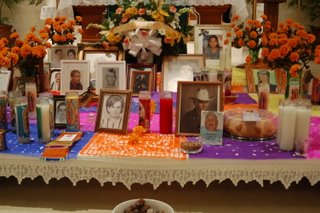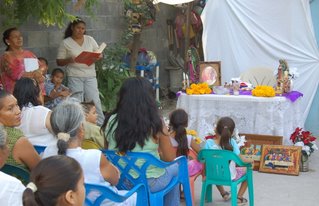 December 12th is the feast of Our Lady of Guadalupe. The Mexican Church, especially, celebrates an event that happened 475 years ago, when an Indian named Juan Diego (Cuauhtlatoatzin was his birth name) was visited four times by the Mother of God, who was dressed as an Indian princess. Juan Diego belonged to the recently conquered (“annihilated” would be more exact) Aztec nation, and the message of the Mother of the Christ was of consolation and solidarity. The Blessed Mother asked that the church build a church on a hillside outside of Mexico City, so that those who were living in misery might have a place to go and raise up their laments to heaven. (Image courtesy of the Divine)
December 12th is the feast of Our Lady of Guadalupe. The Mexican Church, especially, celebrates an event that happened 475 years ago, when an Indian named Juan Diego (Cuauhtlatoatzin was his birth name) was visited four times by the Mother of God, who was dressed as an Indian princess. Juan Diego belonged to the recently conquered (“annihilated” would be more exact) Aztec nation, and the message of the Mother of the Christ was of consolation and solidarity. The Blessed Mother asked that the church build a church on a hillside outside of Mexico City, so that those who were living in misery might have a place to go and raise up their laments to heaven. (Image courtesy of the Divine)

The parish remembers this day with an early morning procession. We started out at 3:30AM, some 150 people, amongst them a great number of young people. We carry our own image of la Guadalupana, and walk about five miles to Our Lady of Guadalupe Church. We are accompanied by matachines, Indian dancers, who brought incense and their own special prayers to the moment.
 In the evening, the youth group offered a presentation of the apparitions—and the faithful lifted up their particular lamentations to this Woman of God. (Photos by Michael Seifert)
In the evening, the youth group offered a presentation of the apparitions—and the faithful lifted up their particular lamentations to this Woman of God. (Photos by Michael Seifert)
 From December 16th until the 24th, the community at San Felipe de Jesus prays a novena in honor of the Holy Family. Known in Spanish as “las posadas” (“posada” means “inn”, as in “there is no room at the inn”), the prayer takes the form of a procession through the streets of the parish. Two children dress as the Virgen Mary (in her ninth month of pregnancy) and the stalwart Joseph, looking for a decent place for the birth of Christ. We arrive at a designated home, where we sing the verses of traditional song (“In the name of God, open up and give us a place to stay!” “We don’t know you! If you don’t leave, we are going to beat you with a stick!” “But I am Joseph and this is Mary the Queen of heaven” “In that case, come on in!” (my translation) and after prayer, enjoy a small party, with tamales, hot chocolate and a piñata for the children. The cold weather is a sharp reminder of the original plight of the Holy Family, and a reminder of how God chose to come amongst us—as a family without a home. (Photos by Michael Seifert)
From December 16th until the 24th, the community at San Felipe de Jesus prays a novena in honor of the Holy Family. Known in Spanish as “las posadas” (“posada” means “inn”, as in “there is no room at the inn”), the prayer takes the form of a procession through the streets of the parish. Two children dress as the Virgen Mary (in her ninth month of pregnancy) and the stalwart Joseph, looking for a decent place for the birth of Christ. We arrive at a designated home, where we sing the verses of traditional song (“In the name of God, open up and give us a place to stay!” “We don’t know you! If you don’t leave, we are going to beat you with a stick!” “But I am Joseph and this is Mary the Queen of heaven” “In that case, come on in!” (my translation) and after prayer, enjoy a small party, with tamales, hot chocolate and a piñata for the children. The cold weather is a sharp reminder of the original plight of the Holy Family, and a reminder of how God chose to come amongst us—as a family without a home. (Photos by Michael Seifert)






